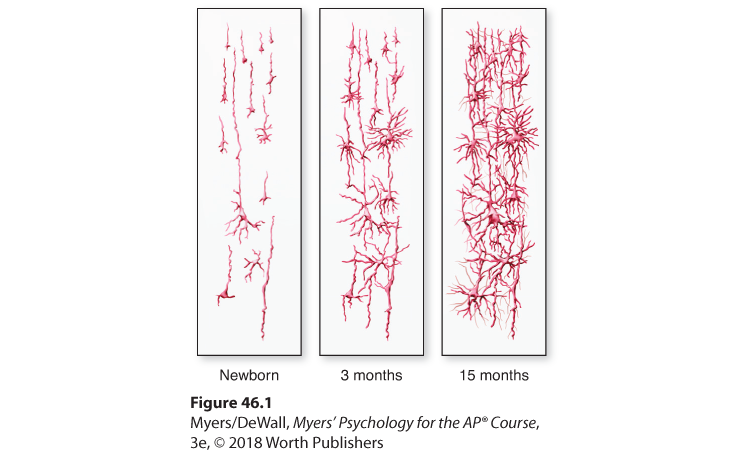Brain Development
In your mother’s womb, your developing brain formed nerve cells at the explosive rate of nearly one-quarter million per minute. The developing brain cortex actually overproduces neurons, with the number peaking at 28 weeks (Rabinowicz et al., 1996, 1999).
From infancy on, brain and mind—neural hardware and cognitive software—develop together. On the day you were born, you had most of the brain cells you would ever have. However, your nervous system was immature: After birth, the brain’s branching neural networks that eventually enabled you to walk, talk, and remember had a wild growth spurt (Figure 46.1). This rapid development helps explain why infant brain size increases rapidly in the early days after birth (Holland et al., 2014). From ages 3 to 6, the most rapid growth was in your frontal lobes, which enable rational planning. During those years, your brain required vast amounts of energy (Kuzawa et al., 2014). This energy-intensive process caused rapid progress in your ability to control your attention and behavior (Garon et al., 2008; Thompson-Schill et al., 2009).

Figure 46.1 Infant brain development
In humans, the brain is immature at birth. As the child matures, the neural networks grow increasingly complex.
“ It is a rare privilege to watch the birth, growth, and first feeble struggles of a living human mind.”
Annie Sullivan, in Helen Keller’s The Story of My Life, 1903
The brain’s association areas—those linked with thinking, memory, and language—were the last cortical areas to develop. As they did, your mental abilities surged (Chugani & Phelps, 1986; Thatcher et al., 1987). Fiber pathways supporting agility, language, and self-control proliferated into puberty. Under the influence of adrenal hormones, tens of billions of synapses formed and organized, while a use-it-or-lose-it pruning process shut down unused links (Paus et al., 1999; Thompson et al., 2000).